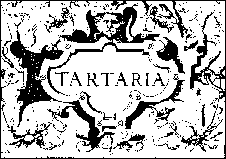|
Beginning of the part
The second half of the XVIIth century
The fisrt half of the XVIIIth century
The second half of the XVIIIth century
The first half of the XIXth century
The second half of the XIXth century
Beginning of the XXth century

Title of Hondius' map
|
Jodocus Hondius' map
The "Atlas" of the famous flamish scientist Gerard Merkator (1512-1594)
was reprinted in Amsterdam in 1606. This publication, prepared by Jodocus Hondius,
carried a new additional map, that wasn't presented in the previous publication in the "Atlas":
the territory of the North Eurasia from Moscow, the White and the Blak Sea in the west
to Korea and the coast of Alaska in the east was marked on the map, ehtitled "Tartaria"
The southern border of the draught lay between 30Ï and 40Ï n.l., the northern -
across the Arctic Ocean.The author of the map, according to the data in the additional
supplement, was Jodocus Hondius. The scientists believe, that the basis of Hondius'
draught were the maps of the Antonio Jenkinson (1562) and Gerard Merkator (1595),
published in Europa in the second half of the XVIth century .
Hondius marked the Ob just from its mouth to the flowing
into the Ocean, while it is drawn not correctly in the Low reaches, than in the Middle
and in the Upper reaches. The Ob takes its birth from the China Lake(Kitai lacus).
In the south a nameless river (may be the Ob?), where the city Taskent is situated,
flows into the lake. And here Jenkinson's confusion can be seen, who identified the
China Lake with in the Upper Ob with the Aral Sea, and the river flowing into this
lake from the south with the Sur-Daria. But Hondius was very carefull about the
supposition, marking Taskent on the bank of the southern river, though non naming
the river Sur-Daria.
The Irtish (Irtisch flu) is shown as a left tributary of the Ob, which took
its birth in the Riphey (Ripheus) Mountains (Ural). The Ob at the place from the
China Lake to the mouth of the Irtish first flew in the mountains (Imaus mons,
Siebi mons), then in the plane, though from the south and the west the Tapuri Mountains
and The Alani Mountains are attached to it.
Despite the considerable mistakes the peculiarities of the relief,
noticed by Hondius, are quite identifical with the geografical realias. In our opinion
the mountiain ridge Imaus, streched from the southern desert to the Polar region,
coincides with the Mongolian and Mountainous Alta, the Sajan and the Jenissey Ridge.
The mountainous ridge Siebi may be identified with the Salair Ridge and the Kuznetsk
Alatow; the spurs of the Mining Altai may be seen in the Tapuri, and the Alani
Mountains may be identified with the Kazakh Hills.
Judging this treatment of the map the present-day Altai Territory coincides with
that part of the Ob, where it flows from the moutains
to the West-Siberian plane. Here Hondius marked 2 towns, one of which is nameless
and the other is called Cambalich. Lower along the river Grustin is marked. This legendary towns were first marked on the map
of Sigizmund Gerberstein, published in 1549. The historians are very carefull about such
data, since there is no proofs of this and their disposal.
|